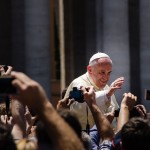Pope Francis’ historic address today before the United States Congress raised up four Americans as inspirations and models of hope, service, and prayer. The choices of Abraham Lincoln and Martin Luther King, Jr. certainly came as no surprise.
But, as this Time article points out, his other choices, Thomas Merton and Dorothy Day, were names probably not very familiar to most of us.
Readers of my blog already know of my affection for Thomas Merton (see here, here, and especially here and here), and the influence of his book on my life, The Seven Storey Mountain. But I haven’t previously discussed servant of God Dorothy Day – Catholic social activist, and founder of The Catholic Worker movement.
I spent a good deal of time last year reading through her journal, The Duty of Delight.
I was challenged.
Not just by the length of her book, or the breadth of her service to the poor.
The challenge was much more profound, and much more moving. It was my first real introduction to the radicalism that is a genuine part of Catholic social doctrine.
A radicalism on behalf of the poor, the displaced, the brutalized, the dismissed.
That radicalism, for this more or less social conservative, both repels and convicts.
But it’s a radicalism fully aligned with the teaching of the Church, the teaching of Christ. No less a conservative than New York Cardinal Dolan had this to say about Day in support of her cause for canonization:
“I am convinced she is a saint for our time. She exemplifies what’s best in Catholic life, that ability we have to be ‘both-and’ not ‘either-or.’
Here is how the New York Times explained just how “conservative-leaning” Catholics have come to see social activist Day:
In recent years, he and other conservative Catholics have come to embrace Day, finding inspiration in her decision to support the church’s opposition to abortion, as well as her distrust of government and her overall religious orthodoxy. As someone who was both committed to social justice and loyal to church teachings, Day bridges wings of the contemporary church in a way that few American Catholic figures can.
But again, Day’s activism is a challenge.
Not a challenge to our faith. But a challenge, certainly, to our hearts. Do we live what we believe?
If not, why not?
Here is just one example of what initially repelled me about Day – yet, ultimately, convicted me.
It is a clear, absolutely devastating critique of President Truman’s decision to use nuclear weapons on Hiroshima, dated September 1945.
A brief except:
Mr. Truman was jubilant. President Truman. True man; what a strange name, come to think of it. We refer to Jesus Christ as true God and true Man. Truman is a true man of his time in that he was jubilant. He was not a son of God, brother of Christ, brother of the Japanese, jubilating as he did. He went from table to table on the cruiser which was bringing him home from the Big Three conference, telling the great news; “jubilant” the newspapers said. Jubilate Deo. We have killed 318,000 Japanese.
She concludes:
Yes, God is still in the picture. God is not mocked. Today, the day of this so great news, God made a madman dance and talk, who had not spoken for twenty years. God sent a typhoon to damage the carrier Hornet. God permitted a fog to obscure vision and a bomber crashed into the Empire State Building. God permits these things. We have to remember it. We are held in God’s hands, all of us, and President Truman too, and these scientists who have created death, but will use it for good. He, God, holds our life and our happiness, our sanity and our health; our lives are in His hands. He is our Creator. Creator.
As I said, challenged.
Do read it all. But please don’t stop there.
Read her diary, or at least a solid biography.
Only then we will get a better glimpse of what Francis has now started us talking about.
And be sure to read this excellent post by Deacon Greg Kandra: Citing Merton and Day, Pope Francis Once Again Turns Attention To The Peripheries.
Peace
Image Credit: Wikimedia Commons, Public Domain

















